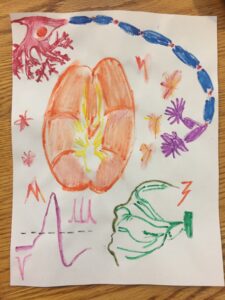
The head and neck’s motor and sensory functions are a result of the twelve bilateral cranial nerves. The trigeminal nerve is the 5th cranial nerve and is the largest (Borges & Casselmann 2010, Rice University 2017). The trigeminal nerve receives input from our face, controls muscle responsible for chewing, and plays a significant role in migraines (Borges & Casselmann 2010, Durham 2004, Rice University 2017).
Migraines are intense headaches that can last broken down into four phases and can last for days. The mechanism that causes migraines is a positive feedback loop that reduces the threshold of the firing of action potential from the trigeminal nociceptive (pain) neurons that send a pain signal to the brain (Giniatullin et al. 2008).
Borges, A., & Casselman, J. (2010). Imaging the trigeminal nerve. European journal of radiology, 74(2), 323-340.
Durham, P. L. (2006). Calcitonin gene‐related peptide (CGRP) and migraine. Headache: The Journal of Head and Face Pain, 46, S3-S8.
Giniatullin, R., Nistri, A., & Fabbretti, E. (2008). Molecular mechanisms of sensitization of pain-transducing P2X 3 receptors by the migraine mediators CGRP and NGF. Molecular neurobiology, 37(1), 83.
Rice University. (2017). Anatomy & physiology. OpenStax. https://openstax.org/details/books/anatomy-and-physiology

Abstract:
Intense headaches, also known as migraines, are the result of 12 bilateral cranial nerves that create a positive feedback loop which triggers a chain reaction resulting in pain neurons to be sent to the brain. This loop begins with the release of calcitonin gene-related peptide (CGRP) which then prompts the release of mediators triggering inflammation. When the inflammation occurs, this then breaks the lower threshold for adenosine triphosphate (ATP) sending trigeminal nociceptive neurons or pain signals to the brain. Within this positive feedback loop there are four phases of the migraine felt by the patient. The prodrome phase, aura phase, headache phase, and postdrome phase are where these actions occur and exhibit or translate to phase distinct symptoms felt by the migraine sufferer. Each phase has a distinct characterization experience for the patient. These phase associated symptoms can range and range from initial identification of an oncoming migraine by specific symptoms exhibited (e.g., light or sound sensitivity, fatigue, unfocused, cravings, increased urination) to numbness or tingling to an intense headache. Pain is a symptom that is commonly associated with migraines. The migraine phases usually close with what is known as a migraine hangover which could include fatigue, difficulty in concentration, and highs or lows in mood. The attached painting is an artistic depiction of the bilateral cranial nerves, positive feedback loop, ATP thresholds, phases, and affected cranial areas.
Peer review:
I found the author’s abstract to be comprehensive and scientifically written. I am not particularly scientifically minded (i.e., math/science is not my strong suit) I was still able to follow the written abstract and see the relation to the art piece. All in all, a well executed project. A+ if I have a vote.